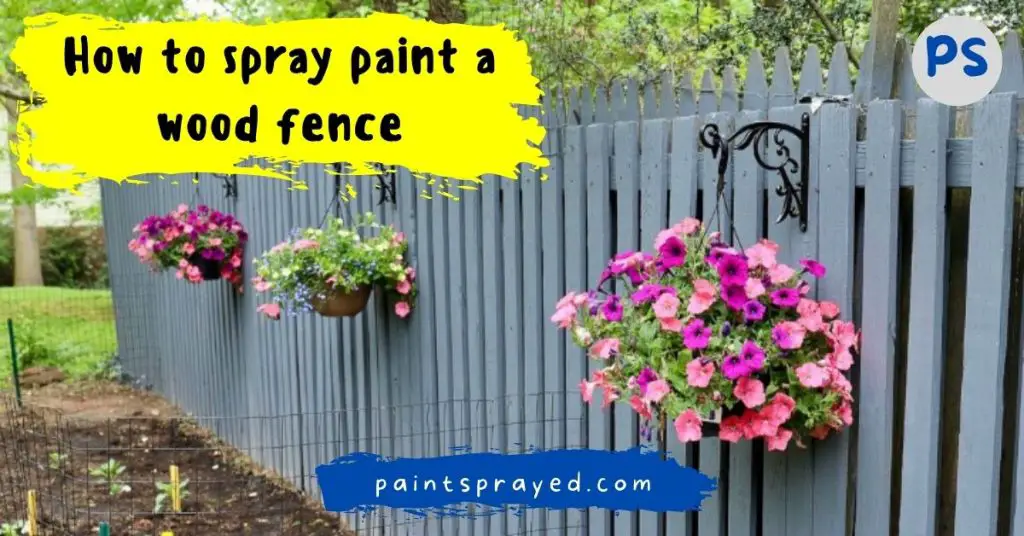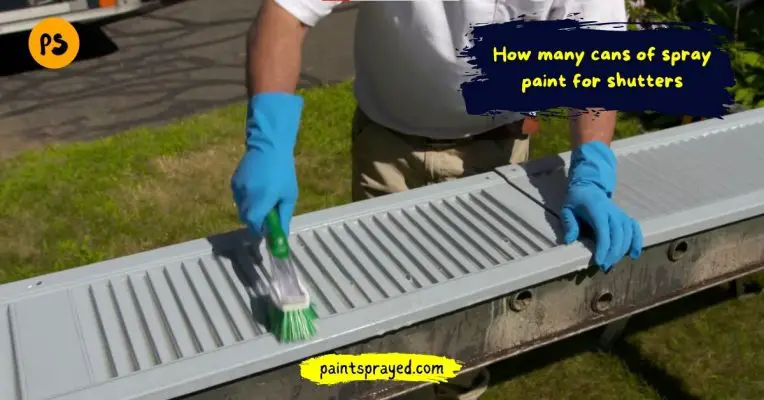Painting a fence or any wood structure is the first step to bringing out the best look of your outdoor area. You’ll undoubtedly ask yourself, how do you paint a fence?
This guide is for those newbies who wanted to get the perfect finish for their wooden fence with spray paint without making any mistakes.
Follow each step explained in this very easy-to-understand step-by-step guide. During your fence painting project, costs can skyrocket if you try to save money by not using a power painter.
Painting a fence by hand is a time-consuming and laborious process.
A paintbrush requires hours to cover large areas, and you can’t paint too much without having brush marks so better use spray paint for a better finish.
You will also know the complete method of how spray painting a fence with gaps.
Remove old paint from wooden fence
The best way to do it yourself is to use a paint and varnish remover or a paint stripper. Depending on the wood fence and the type of paint you want to remove, it will take some time.
You can also remove the old paint yourself and have the wood fence repainted. You can use this time to update the paint color and give it a new look.
Look detailed for removing paint from the wooden surfaces. You can have a look on this guide if you want to remove acrylic paint from wood.
Clean wooden fence for spray painting
The paint will not last long if you don’t get the fence clean. Before you paint, clean the fence with a pressure washer and a special wood cleaner.
Even if you don’t plan on painting, this is the best way to clean a wooden fence.

The wood cleaner will remove oil, dirt, and grime that can compromise the wood barrier, causing it to rot.
The oil and grime will also prevent the new paint from adhering to the wood. Completely dry your wooden fence with a towel before applying a new coat of paint.
Use drop cloths
You can use old drop cloths to protect the surrounding of the wooden fence.
You can lay the drop cloths on the ground around the fence and then spray the fence with water.
The drop cloths will keep the ground from getting dirty and you can simply pull the cloths off the ground and hang it to dry when you are done working.
Another idea is to use a small tarp or piece of plastic to protect the area around the fence.
It can be used to protect the plants and grass from getting dirty when you spray the fence with water.
Start spraying on a wooden fence
To paint your fence properly, it’s very important that you change the spray pattern to match the texture of the fence.
Change it so that it’s a vertical spray for painting a horizontal fence and change one of the jets on the paint spray gun so that it spays both horizontal and vertical patterns.
It only requires a quick pivot at the job site from side to side and you’ll get a smooth even coat with no streaks.
In fact, just two coats done this way is oftentimes all you need for an ultra-smooth finish with excellent coverage.
And let the paint dry completely for 24 hours at least and review if there are any spots left that were undone by you and then fix those spots.
Is it better to spray or paint a fence?
Both spraying and painting a fence have their own advantages and disadvantages.
Spraying a fence is faster and more efficient, as it allows for a larger area to be covered in a shorter amount of time.
It also results in a more even and consistent finish. However, spraying requires specialized equipment and can be messy, making it more difficult to control overspray and clean up.
Painting a fence is more labor-intensive and takes longer, but it allows for greater control over the application and more precise coverage.
It also requires less specialized equipment, making it more accessible for DIY projects.
Ultimately, the decision between spraying or painting a fence will depend on the specific project and the individual’s preferences and resources.
Can you spray paint wooden fence?
Yes, it is possible to spray-paint a wooden fence.
Spray painting can be an efficient and effective way to apply paint to a wooden fence.
As it allows for a larger area to be covered in a shorter amount of time and results in a more even and consistent finish.
However, there are a few things to keep in mind when spray painting a wooden fence:
- Make sure the wood is clean, dry, and free of debris.
- Use a paint that is suitable for outdoor use and designed for wood surfaces.
- Use a paint primer before applying paint, to improve adhesion and protect the wood.
- Use a paint sprayer with an adjustable nozzle, so you can control the width and pattern of the paint spray.
- Take safety precautions such as wearing a mask and goggles, to protect yourself from inhaling paint fumes and overspray.
It is also important to note that spray painting is a messy process and it can be difficult to control overspray, so it’s important to protect any surrounding areas you don’t want to be painted.
Can you use spray paint to paint a fence?
Yes, it is possible to use spray paint to paint a fence. Spray paint can be an efficient and effective way to apply paint to a wooden fence.
As it allows for a larger area to be covered in a shorter amount of time and results in a more even and consistent finish.
When using spray paint to paint a fence, there are a few things to keep in mind:
- Make sure the wood is clean, dry, and free of debris.
- Use a paint that is suitable for outdoor use and designed for wood surfaces.
- Use a paint primer before applying paint, to improve adhesion and protect the wood.
- Use a paint sprayer with an adjustable nozzle, so you can control the width and pattern of the paint spray.
- Take safety precautions such as wearing a mask and goggles, to protect yourself from inhaling paint fumes and overspray.
- Spray paint is messier than brush or roller, so it’s important to protect any surrounding areas you don’t want to be painted.
It is important to note that spray paint is not as durable as paint applied with a brush or roller and also it is not as precise as a brush or roller, and it can be difficult to achieve a smooth finish.
Therefore, it is recommended to use a brush or roller for the corners and hard-to-reach areas of the fence and use spray paint for the larger, flat areas.
What is the best paint to spray on a fence?
When it comes to spray painting a fence, the best paint to use would be exterior paint specifically formulated for wood surfaces.
These types of paints are designed to withstand the elements and provide long-lasting protection for your fence.
Here are some examples of popular paint types that work well for spray painting fences:
- Acrylic paint: This type of paint is water-based, which makes it easy to clean up and it dries quickly. Acrylic paint is also resistant to fading, cracking, and peeling, making it a great option for outdoor wood surfaces.
- Latex paint: This type of paint is also water-based, and it dries quickly. It’s also resistant to fading, cracking, and peeling and is often used in exterior painting.
- Oil-based paint: This type of paint is more durable and resistant to the elements than water-based paint. However, it takes longer to dry and requires mineral spirits or paint thinner to clean up.
It is also important to use a paint primer before applying paint, to improve adhesion and protect the wood.
Ultimately, the best paint to spray on a fence will depend on your specific project and the condition of the wood.
It’s always a good idea to consult the manufacturer’s instructions and test a small area before starting your project.
FAQ’s of How to spray paint a wood fence
Final thoughts on How to spray paint a wood fence
This post was intended to provide a helpful guide on how to paint a fence, and we hope that you have found it useful.
However, if you have any questions or concerns, please contact us down here. We’d be happy to answer any questions or concerns you may have.
Just comment on your query and we will make sure that you get your answer as the first priority. This guide will also help you if you want to know how to spray paint a fence with gaps.
Till the next solution from us take care of yourself and take good care of your fence and clean it regularly to enjoy the fresh paint.

Matthew Edward is a professional painter who loves to paint and wants to share useful tips and tricks which he had learned in many years of experience in painting. He also used many products that can be used for painting he has tried and tested each and every product to give an unbias opinion about it in his review. This blog is very useful for those newbies who want to learn painting without making mistakes.






